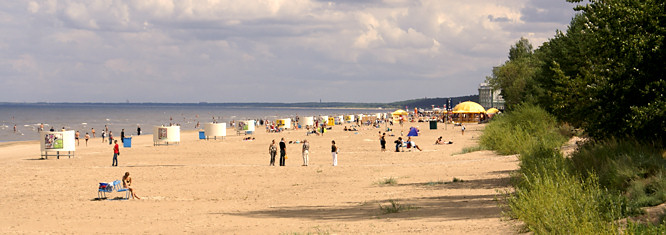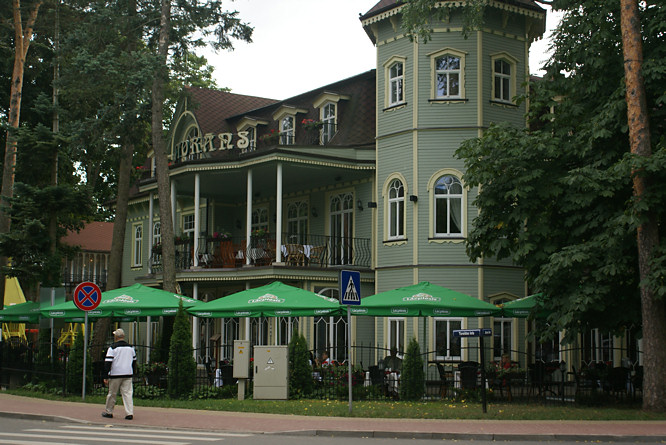Riga Day trip to the Baltic Seaside resort of Jurmala
If you are going to the seaside along the Jurmala coast line (pronounced = Your-mal-A) get off at Majori (pronounced = My-your-E) It only takes 30 minutes to arrive at the Baltic seaside resort of Jurmala (pronounced = Your-mal-A) by train from Riga's central train station. Jurmala is the name for the costal region not a town. It only costs 1.25Lats return. It is so cheap.

The main railway station is near the main market held in the WW1 Zeppelin Hangers. We had a problem finding the entrance until we realised that it was near the tall modern looking tiled clock tower on the main street called Marijasas iela. It is on the other side of the road from the park and backs onto the railway line.
The Station entrance looks like the entrance to a shopping centre rather than a railway station, but look for the big sign that says 'Central Stacija' (central Station). Go to one of the ticket desk numbed 7 to 12 and say Jurmala Majori paldies (pronounced = Your-mal-A My-your-E pall-dee-S). The train always goes from platform 3. Look for the sign that says 'Perons 3' The trains leave every 30 minutes and run from 6am to 10.30pm even on Sunday.
Keep your ticket handy as each coach has a ticket inspector who will want to stamp your ticket. Be careful getting on and off the trains. The platforms are at ground level so you have to climb up a steep ladder to get into the carriage. If you have a baby push chair be ready to take your child out of the seat and lift the push chair onto the train before you climb up the ladder.

Latvian train stations are strange. There are no name signs to help you know what station you have arrived at. Normally only the station office has a sign on it. If your railway carriage is at the back of the train you wont be able to see the sign. There are no seats on most platforms and no cover from the elements. Always try to sit in one of the newer looking railway carriages as they have cloth seats and a digital sign that announces what the next station is.
If there is no room and you have to sit in one of the older carriages you will find the seats are made of plastic and are therefore a bit hot and sticky to sit on in the summer. These carriages do not have the digital station name display device so you have to use a map and count how many stations you have passed.
When you pass over a big river you know that you only have four more stops until you have to get off at Majori. On the other side of the road from the station there is a grass area with a statue of St George killing the dragon and a path that leads to an attractive 1920s hotel. Most of the train passengers will head that way. Just follow them because you want to turn right down the road in front of that hotel. It is called Jomas iela and is the main shopping street. It is very long and in the summer full of interesting restaurants, stalls, bars and seaside shops.
It is a very pleasant place to stroll and people watch. The whole resort is built in a forest. There are trees everywhere. At the end of the road turn left along Turaidas iela until you find the beach. Where the forest ends the beach begins. In the summer local restaurants and bars pitch marquee tents and sell food and drink. There are toilets and changing rooms available. The sand is good quality and ideal for making sand castles.
Beach volley ball is very popular. Take your shoes and socks off and go for a paddle in the sea. Turn left and head towards a large modern hotel complex in the distance. Walk past it and then take one of the next exits off the beach. Head back towards Jomas iela the main shopping street and then walk back to the Majori Railway station.
The Latvian landscape
I had a shock when we flew into Latvia. I knew that Estonia, Latvia and Lithuania are flat low lying countries. I expected to find large wide open farmer's fields planted with lots of different crops. I was wrong. The Latvian landscape is very similar to neighbouring Scandinavia. The countryside is mainly forested with small fields and villages in the clearings. It is very attractive. There are some areas that are an exception. The coastline has miles of sandy beaches with hardly any commercial development. Behind the beaches you normally find acres of forest
Latvian Railway history museum
If you like old trains or you are visiting Riga with young children you will enjoy a visit to the Latvian Railway history museum. www.railwaymuseum.lv/ritosais-eng1.htm. It is only a 10 minute walk from the old town: walk over the main river bridge to the west bank and it is on your left about 200 yards from the river. The museum is on the street called Uzvaras bulvaris at the junction with Valguma iela. It is a rare opportunity to see soviet trains and rolling stock. There is also a colourfully restored class 52 steam train built at 'Henschel and Sohn GmbH' works in Kassel, Germany in 1942. during WW2.
Brief History of Latvia
Latvia has been occupied and attacked by many different nations. Germany, Poland Sweden, Russia and France. In the 20th Century German and Soviet Armies fought over ownership of Latvia. Latvia has only been independent for a total of 29 years during that century. The first time was between 1920 until 1940 when the Red Army invaded. The second time independence was declared was in 1991. Hopefully this century it will remain independent.
Riga is first mentioned in historical documents in 1198. The German bishop of Bremen lays the foundation of the medieval town in 1201 and it joins the Hanseatic League of Baltic trading port towns. Although the town was multinational the majority of the population were German. Germanic Knights returning from the crusade in the holy land turned their attention to converting the pagans of the Baltic coast to Christianity
They became known as the Teutonic Knights and took over most of northeast Poland, Lithuania, Latvia and Estonia. A Polish back revolt lead to Poland controlling Riga from 1581. In 1621 the Swedish army occupies Riga until 1710 when the Russian Tsar Peter the great conquers the city. In 1812 Napoleon's army comes close to the city and burn it's suburbs down, thus creating conditions for the present grid street planning and construction.
The French retreat pursued by the Russian Army. Most of Riga's old town defences are dismantled in 1857. Riga is prosperous and is now one of the most important towns in Russia where industry and trade flourish. In 1914 Russia declares war on Germany and the front line moves towards Latvia as the Russian army suffers defeat. The Russian revolution in 1917 leads to the independent state of Latvia being declared in 1920.
During world war two as part of a non aggression agreement with Germany the Red army marches into Latvia and Riga.in 1940. The communist Soviet system is established in Latvia and the first wave of mass deportation of Latvian citizens to work camps and death in the cold of Siberia begin. German troops attack Russia and occupy Latvia in 1941. At first they are greeted as saviours but then deportations to German work and death camps begin. The Soviet Red army recapture Latvia in 1944.
The second wave of mass deportation of Latvian citizens to work camps and death in the cold of Siberia start in 1949. The communists transport large numbers of Russian settlers into Latvia to work in the new factories that are built. Latvians feel like they are second-class citizens in their own country. After the Berlin wall falls in 1989 the dream of independence is again realised. In 1991 Latvia declares itself independent and later joins the EU.
Today 42% of the population of Latvia are of Russian origin and 42% are of Latvian origin. The remaining minority are made up of Poles, Ukranians, and Belorussians. Latvia's history has left its with problems. You will meet Russian speaking Latvians in Riga. They maybe second or third generation Latvians. Their family may be of Russian origin but they consider them selves as Latvians not Russians. They went to Latvian schools where all the lessons were in Latvian. The Latvian's do not consider the Russian Latvians as true Latvians. This is where the potential for conflict exists.
Riga Taxi tips
Avoid taxis waiting outside major hotels. They are more like mini-cabs than taxis. They tend to charge more and do not have meters. If you do use them always ask the cost of your journey first. If you do not like the price you can haggle or walk to the Taxi behind and ask his price for the same journey. He will normally be cheaper.
Travel books

